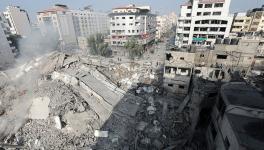Unrest in Mongolia: Who Stands to Gain?
Week-long anti-government protests in Ulaanbaatar show no signs of abating, Mongolia, December 9, 2022
The Kremlin spokesman Dmitry Peskov said in a TV interview in Moscow on Sunday, when asked about where the relationship between Russia and the West is moving, “Well, we are not moving. We have already arrived at a station named ‘Confrontation’, and we have to be reserved, strong, to have underlying strength, because we will have to live in the environment of this confrontation.”
There are no peace talks and no end in sight to the conflict in Ukraine. President Vladimir Putin said last week that Moscow’s near-total loss of trust in the West would make an eventual settlement over Ukraine much harder to reach, and warned of a protracted war.
In such an apocalyptic scenario, Russia’s immediate neighbourhood is turning into severely contested zones of superpower confrontation, as the US and EU try to encircle Russia with a ring of unfriendly states.
Such confrontation can take different forms. In the Transcaucasian region, the Western efforts aim to replace Russia as the arbiter between Armenia and Azerbaijan. The EU has presented itself as an alternative to the Russian mediation and peacekeeping.
Moscow viewed such attempts rather complacently initially, but has lately has begun worrying that the ground beneath its feet is shifting in Transcaucasia. The Western ploy is to incrementally elbow out the Russian peacekeeping force deployed to the region following the renewed conflict between Armenia and Azerbaijan last year over the breakaway region of Nagorno-Karabakh.
Moscow plays both sides in the conflict and, quite obviously, the trapeze act is very delicate and taxing. Thus, in the period since Moscow’s special military operation began on February 24, the EU has succeeded in establishing a “monitoring mission” in Armenia and is advancing its plan to establish an OSCE mission to the region, which will challenge Russia’s monopoly in peacekeeping on the Armenia-Azerbaijan border.
Another active theatre of contestation is Kazakhstan where the West is constantly working to erode that country’s close relations with Russia. Kazakhstan’s multi-vector foreign policy aimed at attracting western investment has created pro-western interest groups among the country’s elites. Kazakhstan’s nationality question also creates sensitivity in its relations with Russia. Kazakhstan is a high stakes game for the West, as it borders China, too.
In comparison, the covert Western role in fuelling the recent clashes between Kyrgyzstan and Tajikistan as well as in encouraging Dushanbe to provide a “transit corridor” for the anti-Taliban rebels in Panjshir Valley poses a direct challenge to Russia in the security sphere. But much to the disappointment of the US, as tensions between Tajikistan and Kyrgyzstan flared last September and soldiers from Kyrgyzstan and Tajikistan exchanged gunfire along several points of the countries’ undemarcated border, Moscow and Beijing chose to remain on the sidelines.
To be sure, the conflict was among the most serious interstate military escalations in Central Asia’s history since the dissolution of the Soviet Union in 1991. The conflict posed a big embarrassment to Moscow and Russia-led regional security organisations in Central Asia.
If the Western role in the Kyrgyz-Tajik conflict was a covert one, that is not the case with its increasingly proactive moves to build up the Panjshiris in Afghanistan as a “moderate” resistance movement to overthrow the Taliban government in Kabul, which enjoys cordial relations with Russia. The Panjshiris enjoyed the patronage of the French intelligence during the anti-Soviet struggle in the 1980s and the old links have been revived. The French President Emmanuel Macron has taken a hands-on role to cultivate his Tajik counterpart Emomali Rahmon.
Quite obviously, both in the case of the Kyrgyz-Tajik hostilities and in the spectre of another round of civil war in Afghanistan haunting the region, Russia’s security interests come under profound challenge. Russia remains the dominant presence in Central Asia and at the leadership level, Moscow wields much influence in Bishkek and Dushanbe. But the intra-regional strife and instability provide fertile ground for western manipulation of the ruling elites.
However, the latest wave of unrest in Mongolia carries ominous signs of a colour revolution. As in Kazakhstan and Kyrgyzstan, the social media is active in stirring up protests. The protests began a week ago against the “coal mafia,” which has been allegedly profiteering from doing business with Chinese companies. But various conspiracy theories are spreading on Twitter, including that there would be an internal power struggle within the ruling party elites.
The government responded promptly with the cabinet deciding to put in the public domain for scrutiny nine contracts related to the state mining company at the heart of the affair and announcing that all future business deals on coal export will be with public knowledge. The government further announced that a parliamentary committee will probe the scandal.
Several hundred protesters gathered in the freezing cold at the city’s Sukhbaatar Square during the weekend and marched to the presidential residence with some people attempting to force their way inside the building, chanting and singing while stamping their feet to stay warm — eerily similar to the coup in Kiev in 2014.
Indeed, what lends enchantment to the view, from the geopolitical perspective, is that China is the destination of most of landlocked Mongolia’s exports of coal, cashmere, livestock and other resources.
The attempt at transforming the protests into an ocular revolution proper is still work in progress. According to the Associated Press, “Economic conditions have deteriorated in the country of roughly 3.3 million as inflation has soared to 15.2% which has been exacerbated due in part to Russia’s invasion of Ukraine.”
Coincidence or not, the protests in Ulaanbaatar followed the state visit by the president of Mongolia Ukhnaagiin Khurelsukh to Beijing last month. This was the second meeting between Xi and Khurelsukh in two months. Beijing understands that it is also in the crosshairs of the West’s diplomacy in Mongolia, Kazakhstan, Kyrgyzstan, Tajikistan and Afghanistan. All these four countries fall in the first circle of Chinese interests in one way or another.
They give “strategic depth” to China; the economic ties with these resource-rich countries are not only hugely beneficial but also growing rapidly; they are irreplaceable partners from the angle of connectivity and the Belt and Road Initiative; and, regional security and stability are common concerns.
The paradox is, despite the convergence of interests and strong political and economic interests, and although their core interests are involved, it is becoming increasingly uncertain whether Russia or China can deliver on regional security guarantees. Moscow is under Western sanctions and Beijing remains extremely wary of confronting the US or the EU — although Mongolia is one country in Central Asia where the core interests of Russia and China overlap.
The US and EU are calculating that this is the best opportunity to consolidate and expand their influence in Russia’s Trans-Caucasian, Caspian and Central Asian backyard. Clearly, the Western powers are wading into the regional tensions and the probability of the Russian and Chinese opposition to it falling short cannot be ruled out.
The geopolitical stakes are high. Mongolia is the transit country for the proposed Power of Siberia 2 gas pipeline channeling up to 50 billion cubic meters of gas from the Yamal Peninsula in the Russian Arctic to eastern China, and the construction work is due to start in 2024. Similarly, China, Mongolia and Russia have extended the Outline of the Development Plan on Establishing the China-Mongolia-Russia Economic Corridor by five years, which will unleash great economic potential and upgrade Mongolia’s role as a transit hub.
China-Mongolia cooperation on the construction of transportation routes and corridors has been greatly boosted in recent years, which has strengthened the logistics between China and Mongolia and greatly increased their transport capacity for bulk commodities, especially mineral products. The two countries are looking to dock multiple new railway lines with Chinese ports.
The US and the EU will do their utmost to wean Mongolia away from the Sino-Russian orbit, no matter what it takes. Interestingly, a NATO military delegation from Brussels travelled to Ulaanbaatar last week and held two days of talks with the Mongolian military leaders. Mongolia presents a combustible mix where all the key elements of the US’ confrontation with Russia and China are present, ranging from NATO’s mission creep to the Asia-Pacific to the BRI and Russia’s energy exports and of course the vast deposits of rare earths in the steppe.
MK Bhadrakumar is a former diplomat. He was India’s ambassador to Uzbekistan and Turkey. The views are personal.
Get the latest reports & analysis with people's perspective on Protests, movements & deep analytical videos, discussions of the current affairs in your Telegram app. Subscribe to NewsClick's Telegram channel & get Real-Time updates on stories, as they get published on our website.
























